stop start INFINITI QX50 2021 Workshop Manual
[x] Cancel search | Manufacturer: INFINITI, Model Year: 2021, Model line: QX50, Model: INFINITI QX50 2021Pages: 542, PDF Size: 3.51 MB
Page 333 of 542
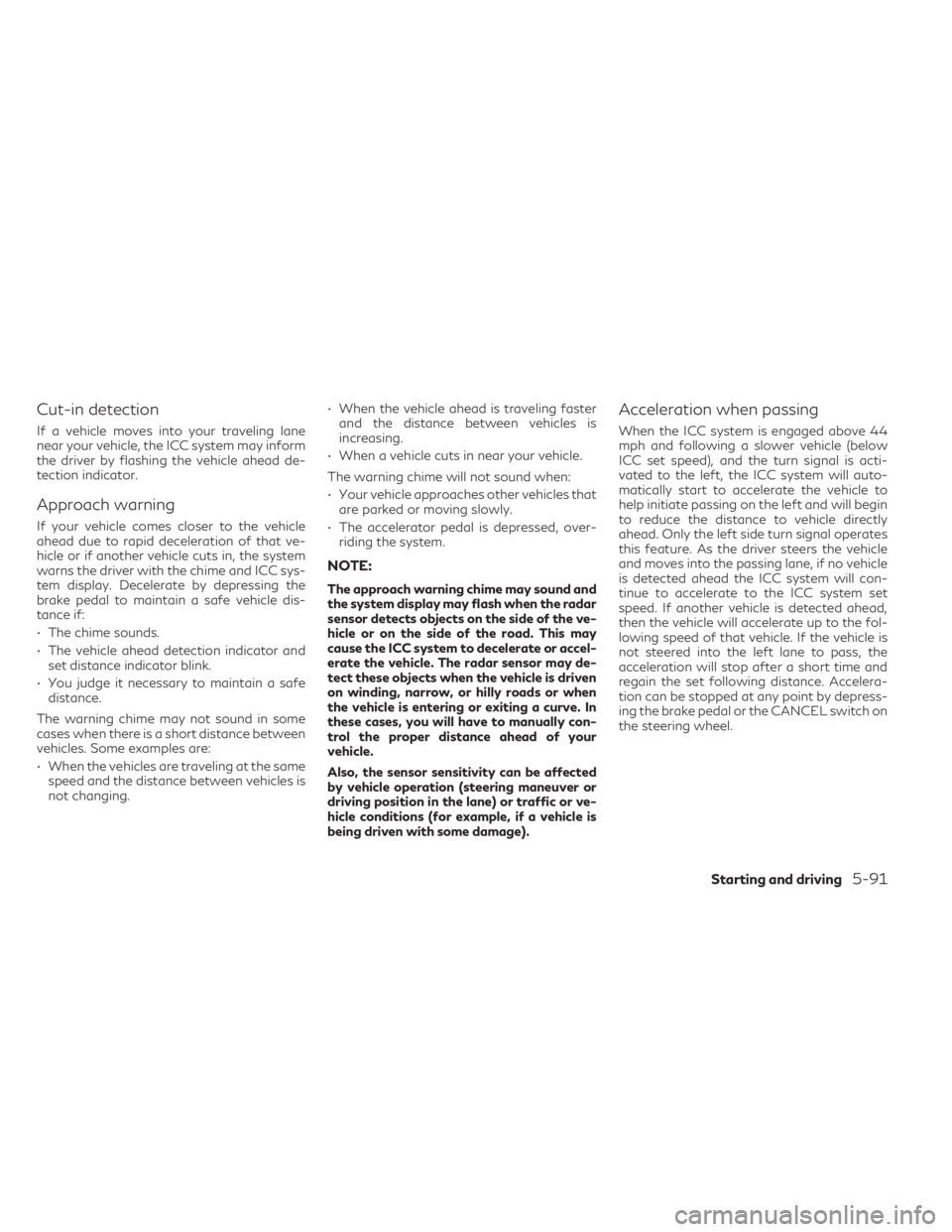
Cut-in detection
If a vehicle moves into your traveling lane
near your vehicle, the ICC system may inform
the driver by flashing the vehicle ahead de-
tection indicator.
Approach warning
If your vehicle comes closer to the vehicle
ahead due to rapid deceleration of that ve-
hicle or if another vehicle cuts in, the system
warns the driver with the chime and ICC sys-
tem display. Decelerate by depressing the
brake pedal to maintain a safe vehicle dis-
tance if:
• The chime sounds.
• The vehicle ahead detection indicator andset distance indicator blink.
• You judge it necessary to maintain a safe distance.
The warning chime may not sound in some
cases when there is a short distance between
vehicles. Some examples are:
• When the vehicles are traveling at the same speed and the distance between vehicles is
not changing. • When the vehicle ahead is traveling faster
and the distance between vehicles is
increasing.
• When a vehicle cuts in near your vehicle.
The warning chime will not sound when:
• Your vehicle approaches other vehicles that are parked or moving slowly.
• The accelerator pedal is depressed, over- riding the system.
NOTE:
The approach warning chime may sound and
the system display may flash when the radar
sensor detects objects on the side of the ve-
hicle or on the side of the road. This may
cause the ICC system to decelerate or accel-
erate the vehicle. The radar sensor may de-
tect these objects when the vehicle is driven
on winding, narrow, or hilly roads or when
the vehicle is entering or exiting a curve. In
these cases, you will have to manually con-
trol the proper distance ahead of your
vehicle.
Also, the sensor sensitivity can be affected
by vehicle operation (steering maneuver or
driving position in the lane) or traffic or ve-
hicle conditions (for example, if a vehicle is
being driven with some damage).
Acceleration when passing
When the ICC system is engaged above 44
mph and following a slower vehicle (below
ICC set speed), and the turn signal is acti-
vated to the left, the ICC system will auto-
matically start to accelerate the vehicle to
help initiate passing on the left and will begin
to reduce the distance to vehicle directly
ahead. Only the left side turn signal operates
this feature. As the driver steers the vehicle
and moves into the passing lane, if no vehicle
is detected ahead the ICC system will con-
tinue to accelerate to the ICC system set
speed. If another vehicle is detected ahead,
then the vehicle will accelerate up to the fol-
lowing speed of that vehicle. If the vehicle is
not steered into the left lane to pass, the
acceleration will stop after a short time and
regain the set following distance. Accelera-
tion can be stopped at any point by depress-
ing the brake pedal or the CANCEL switch on
the steering wheel.
Starting and driving5-91
Page 334 of 542
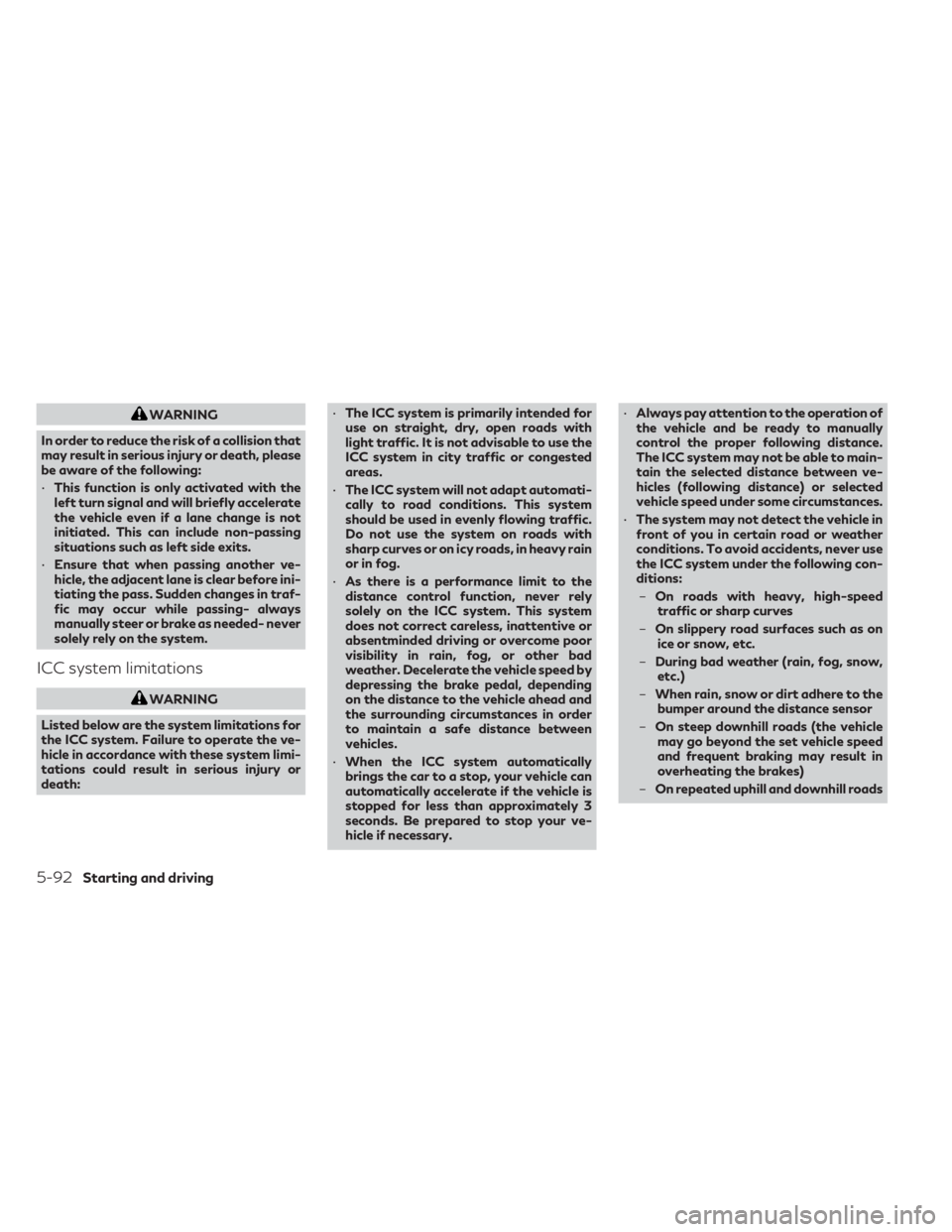
WARNING
In order to reduce the risk of a collision that
may result in serious injury or death, please
be aware of the following:
• This function is only activated with the
left turn signal and will briefly accelerate
the vehicle even if a lane change is not
initiated. This can include non-passing
situations such as left side exits.
• Ensure that when passing another ve-
hicle, the adjacent lane is clear before ini-
tiating the pass. Sudden changes in traf-
fic may occur while passing- always
manually steer or brake as needed- never
solely rely on the system.
ICC system limitations
WARNING
Listed below are the system limitations for
the ICC system. Failure to operate the ve-
hicle in accordance with these system limi-
tations could result in serious injury or
death: •
The ICC system is primarily intended for
use on straight, dry, open roads with
light traffic. It is not advisable to use the
ICC system in city traffic or congested
areas.
• The ICC system will not adapt automati-
cally to road conditions. This system
should be used in evenly flowing traffic.
Do not use the system on roads with
sharp curves or on icy roads, in heavy rain
or in fog.
• As there is a performance limit to the
distance control function, never rely
solely on the ICC system. This system
does not correct careless, inattentive or
absentminded driving or overcome poor
visibility in rain, fog, or other bad
weather. Decelerate the vehicle speed by
depressing the brake pedal, depending
on the distance to the vehicle ahead and
the surrounding circumstances in order
to maintain a safe distance between
vehicles.
• When the ICC system automatically
brings the car to a stop, your vehicle can
automatically accelerate if the vehicle is
stopped for less than approximately 3
seconds. Be prepared to stop your ve-
hicle if necessary. •
Always pay attention to the operation of
the vehicle and be ready to manually
control the proper following distance.
The ICC system may not be able to main-
tain the selected distance between ve-
hicles (following distance) or selected
vehicle speed under some circumstances.
• The system may not detect the vehicle in
front of you in certain road or weather
conditions. To avoid accidents, never use
the ICC system under the following con-
ditions:
– On roads with heavy, high-speed
traffic or sharp curves
– On slippery road surfaces such as on
ice or snow, etc.
– During bad weather (rain, fog, snow,
etc.)
– When rain, snow or dirt adhere to the
bumper around the distance sensor
– On steep downhill roads (the vehicle
may go beyond the set vehicle speed
and frequent braking may result in
overheating the brakes)
– On repeated uphill and downhill roads
5-92Starting and driving
Page 337 of 542
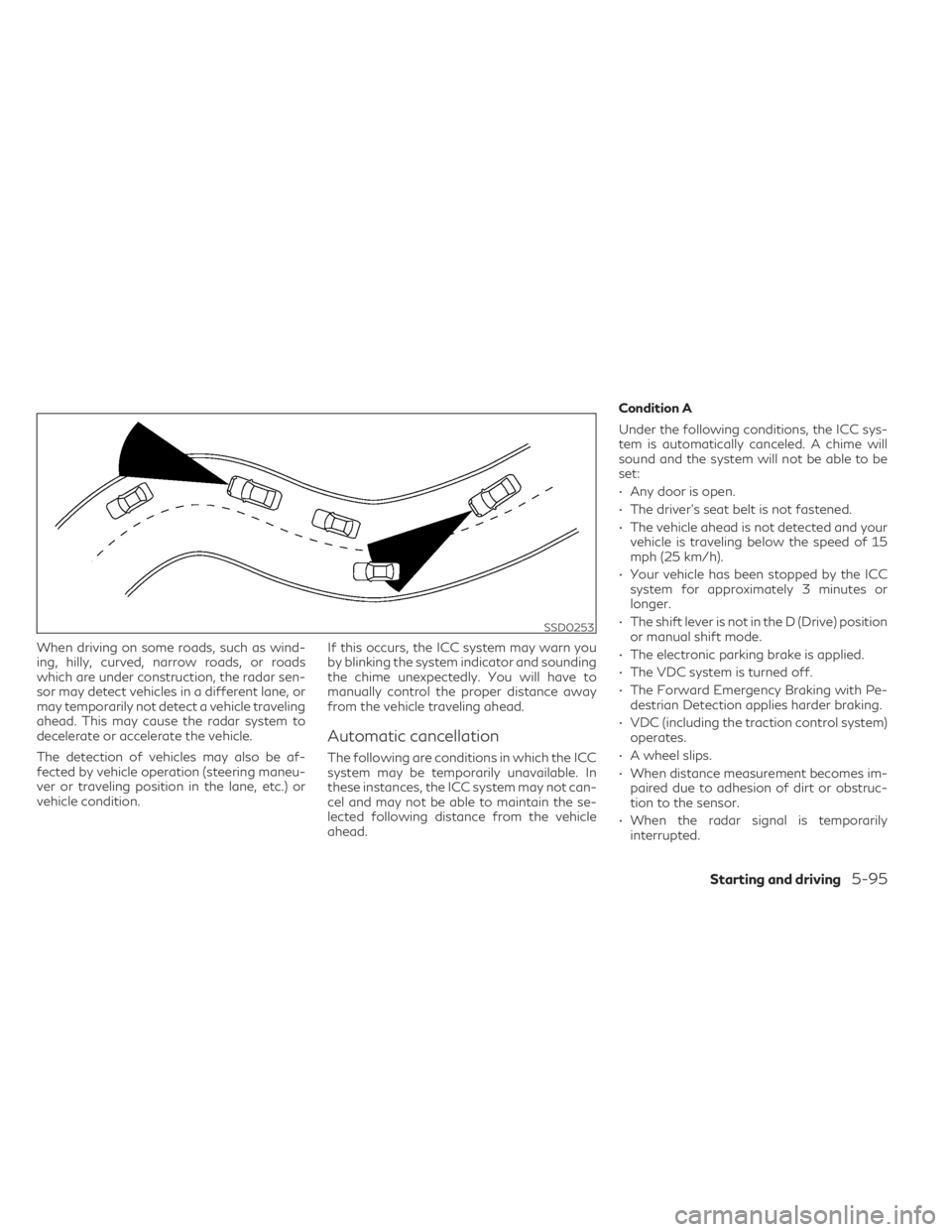
When driving on some roads, such as wind-
ing, hilly, curved, narrow roads, or roads
which are under construction, the radar sen-
sor may detect vehicles in a different lane, or
may temporarily not detect a vehicle traveling
ahead. This may cause the radar system to
decelerate or accelerate the vehicle.
The detection of vehicles may also be af-
fected by vehicle operation (steering maneu-
ver or traveling position in the lane, etc.) or
vehicle condition.If this occurs, the ICC system may warn you
by blinking the system indicator and sounding
the chime unexpectedly. You will have to
manually control the proper distance away
from the vehicle traveling ahead.
Automatic cancellation
The following are conditions in which the ICC
system may be temporarily unavailable. In
these instances, the ICC system may not can-
cel and may not be able to maintain the se-
lected following distance from the vehicle
ahead.Condition A
Under the following conditions, the ICC sys-
tem is automatically canceled. A chime will
sound and the system will not be able to be
set:
• Any door is open.
• The driver’s seat belt is not fastened.
• The vehicle ahead is not detected and your
vehicle is traveling below the speed of 15
mph (25 km/h).
• Your vehicle has been stopped by the ICC system for approximately 3 minutes or
longer.
• The shift lever is not in the D (Drive) position or manual shift mode.
• The electronic parking brake is applied.
• The VDC system is turned off.
• The Forward Emergency Braking with Pe- destrian Detection applies harder braking.
• VDC (including the traction control system) operates.
• A wheel slips.
• When distance measurement becomes im- paired due to adhesion of dirt or obstruc-
tion to the sensor.
• When the radar signal is temporarily interrupted.
SSD0253
Starting and driving5-95
Page 338 of 542
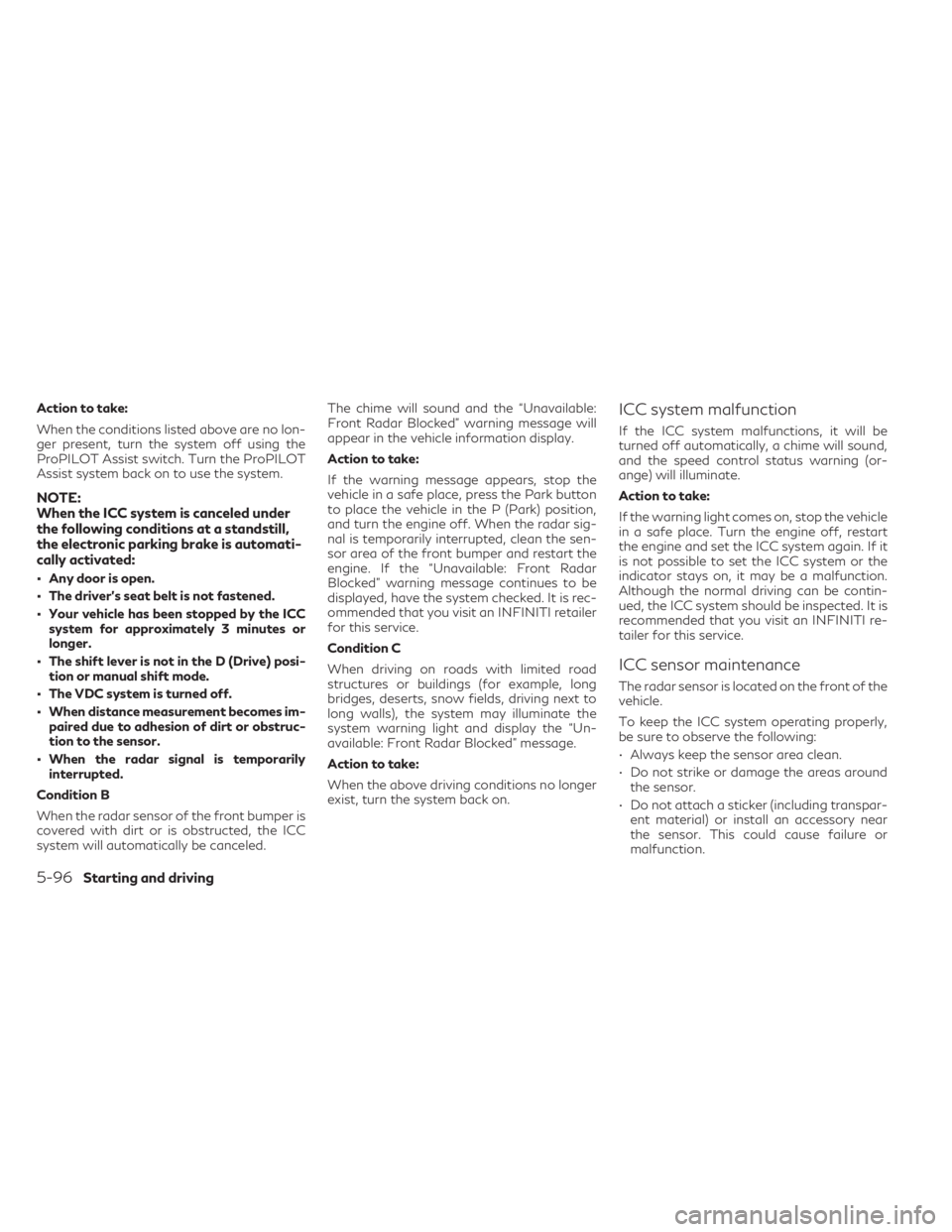
Action to take:
When the conditions listed above are no lon-
ger present, turn the system off using the
ProPILOT Assist switch. Turn the ProPILOT
Assist system back on to use the system.
NOTE:
When the ICC system is canceled under
the following conditions at a standstill,
the electronic parking brake is automati-
cally activated:
• Any door is open.
• The driver’s seat belt is not fastened.
• Your vehicle has been stopped by the ICCsystem for approximately 3 minutes or
longer.
• The shift lever is not in the D (Drive) posi- tion or manual shift mode.
• The VDC system is turned off.
• When distance measurement becomes im- paired due to adhesion of dirt or obstruc-
tion to the sensor.
• When the radar signal is temporarily interrupted.
Condition B
When the radar sensor of the front bumper is
covered with dirt or is obstructed, the ICC
system will automatically be canceled. The chime will sound and the “Unavailable:
Front Radar Blocked” warning message will
appear in the vehicle information display.
Action to take:
If the warning message appears, stop the
vehicle in a safe place, press the Park button
to place the vehicle in the P (Park) position,
and turn the engine off. When the radar sig-
nal is temporarily interrupted, clean the sen-
sor area of the front bumper and restart the
engine. If the “Unavailable: Front Radar
Blocked” warning message continues to be
displayed, have the system checked. It is rec-
ommended that you visit an INFINITI retailer
for this service.
Condition C
When driving on roads with limited road
structures or buildings (for example, long
bridges, deserts, snow fields, driving next to
long walls), the system may illuminate the
system warning light and display the “Un-
available: Front Radar Blocked” message.
Action to take:
When the above driving conditions no longer
exist, turn the system back on.
ICC system malfunction
If the ICC system malfunctions, it will be
turned off automatically, a chime will sound,
and the speed control status warning (or-
ange) will illuminate.
Action to take:
If the warning light comes on, stop the vehicle
in a safe place. Turn the engine off, restart
the engine and set the ICC system again. If it
is not possible to set the ICC system or the
indicator stays on, it may be a malfunction.
Although the normal driving can be contin-
ued, the ICC system should be inspected. It is
recommended that you visit an INFINITI re-
tailer for this service.
ICC sensor maintenance
The radar sensor is located on the front of the
vehicle.
To keep the ICC system operating properly,
be sure to observe the following:
• Always keep the sensor area clean.
• Do not strike or damage the areas around
the sensor.
• Do not attach a sticker (including transpar- ent material) or install an accessory near
the sensor. This could cause failure or
malfunction.
5-96Starting and driving
Page 342 of 542
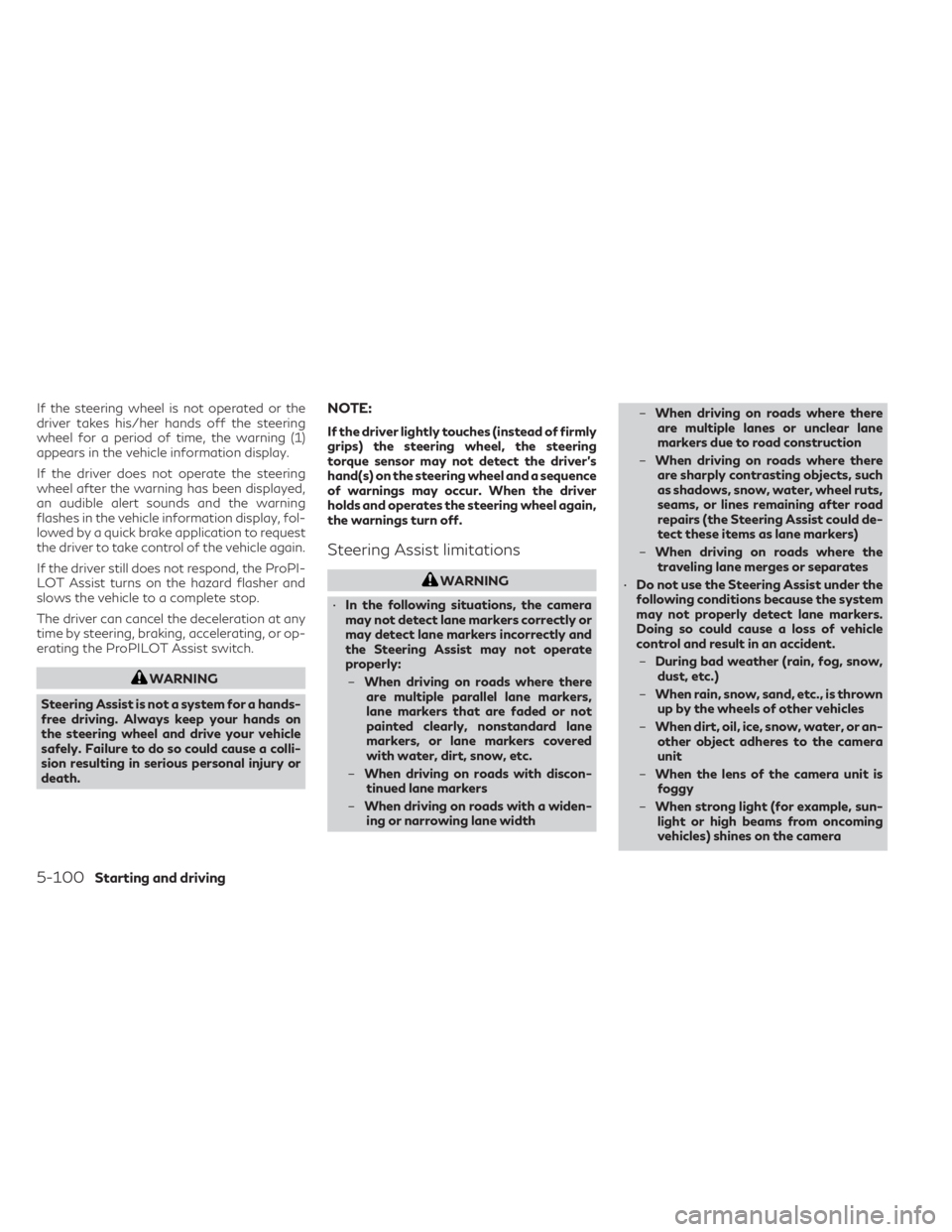
If the steering wheel is not operated or the
driver takes his/her hands off the steering
wheel for a period of time, the warning (1)
appears in the vehicle information display.
If the driver does not operate the steering
wheel after the warning has been displayed,
an audible alert sounds and the warning
flashes in the vehicle information display, fol-
lowed by a quick brake application to request
the driver to take control of the vehicle again.
If the driver still does not respond, the ProPI-
LOT Assist turns on the hazard flasher and
slows the vehicle to a complete stop.
The driver can cancel the deceleration at any
time by steering, braking, accelerating, or op-
erating the ProPILOT Assist switch.
WARNING
Steering Assist is not a system for a hands-
free driving. Always keep your hands on
the steering wheel and drive your vehicle
safely. Failure to do so could cause a colli-
sion resulting in serious personal injury or
death.
NOTE:
If the driver lightly touches (instead of firmly
grips) the steering wheel, the steering
torque sensor may not detect the driver’s
hand(s) on the steering wheel and a sequence
of warnings may occur. When the driver
holds and operates the steering wheel again,
the warnings turn off.
Steering Assist limitations
WARNING
• In the following situations, the camera
may not detect lane markers correctly or
may detect lane markers incorrectly and
the Steering Assist may not operate
properly:
– When driving on roads where there
are multiple parallel lane markers,
lane markers that are faded or not
painted clearly, nonstandard lane
markers, or lane markers covered
with water, dirt, snow, etc.
– When driving on roads with discon-
tinued lane markers
– When driving on roads with a widen-
ing or narrowing lane width –
When driving on roads where there
are multiple lanes or unclear lane
markers due to road construction
– When driving on roads where there
are sharply contrasting objects, such
as shadows, snow, water, wheel ruts,
seams, or lines remaining after road
repairs (the Steering Assist could de-
tect these items as lane markers)
– When driving on roads where the
traveling lane merges or separates
• Do not use the Steering Assist under the
following conditions because the system
may not properly detect lane markers.
Doing so could cause a loss of vehicle
control and result in an accident.
– During bad weather (rain, fog, snow,
dust, etc.)
– When rain, snow, sand, etc., is thrown
up by the wheels of other vehicles
– When dirt, oil, ice, snow, water, or an-
other object adheres to the camera
unit
– When the lens of the camera unit is
foggy
– When strong light (for example, sun-
light or high beams from oncoming
vehicles) shines on the camera
5-100Starting and driving
Page 344 of 542
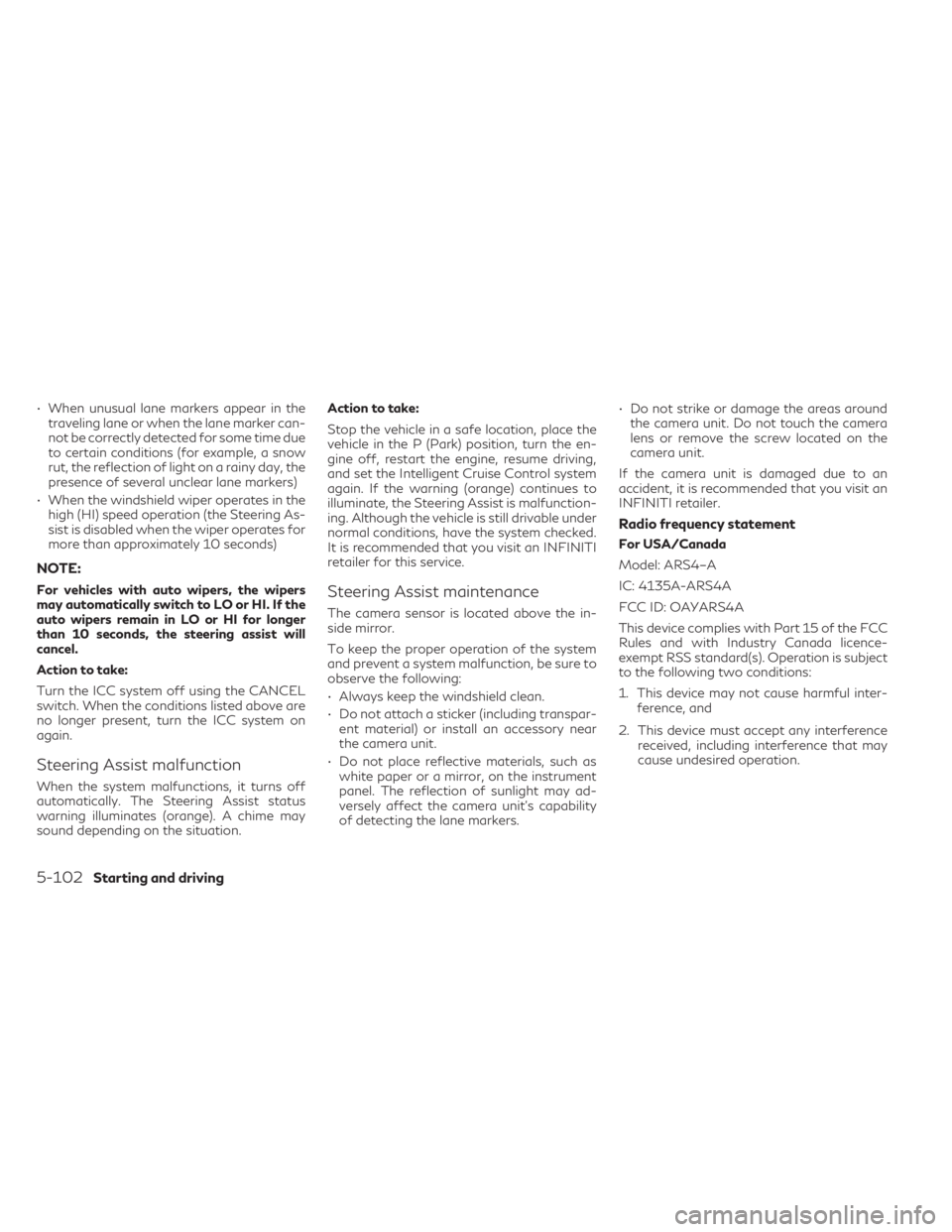
• When unusual lane markers appear in thetraveling lane or when the lane marker can-
not be correctly detected for some time due
to certain conditions (for example, a snow
rut, the reflection of light on a rainy day, the
presence of several unclear lane markers)
• When the windshield wiper operates in the high (HI) speed operation (the Steering As-
sist is disabled when the wiper operates for
more than approximately 10 seconds)
NOTE:
For vehicles with auto wipers, the wipers
may automatically switch to LO or HI. If the
auto wipers remain in LO or HI for longer
than 10 seconds, the steering assist will
cancel.
Action to take:
Turn the ICC system off using the CANCEL
switch. When the conditions listed above are
no longer present, turn the ICC system on
again.
Steering Assist malfunction
When the system malfunctions, it turns off
automatically. The Steering Assist status
warning illuminates (orange). A chime may
sound depending on the situation. Action to take:
Stop the vehicle in a safe location, place the
vehicle in the P (Park) position, turn the en-
gine off, restart the engine, resume driving,
and set the Intelligent Cruise Control system
again. If the warning (orange) continues to
illuminate, the Steering Assist is malfunction-
ing. Although the vehicle is still drivable under
normal conditions, have the system checked.
It is recommended that you visit an INFINITI
retailer for this service.
Steering Assist maintenance
The camera sensor is located above the in-
side mirror.
To keep the proper operation of the system
and prevent a system malfunction, be sure to
observe the following:
• Always keep the windshield clean.
• Do not attach a sticker (including transpar-
ent material) or install an accessory near
the camera unit.
• Do not place reflective materials, such as white paper or a mirror, on the instrument
panel. The reflection of sunlight may ad-
versely affect the camera unit’s capability
of detecting the lane markers. • Do not strike or damage the areas around
the camera unit. Do not touch the camera
lens or remove the screw located on the
camera unit.
If the camera unit is damaged due to an
accident, it is recommended that you visit an
INFINITI retailer.
Radio frequency statement
For USA/Canada
Model: ARS4–A
IC: 4135A-ARS4A
FCC ID: OAYARS4A
This device complies with Part 15 of the FCC
Rules and with Industry Canada licence-
exempt RSS standard(s). Operation is subject
to the following two conditions:
1. This device may not cause harmful inter- ference, and
2. This device must accept any interference received, including interference that may
cause undesired operation.
5-102Starting and driving
Page 349 of 542
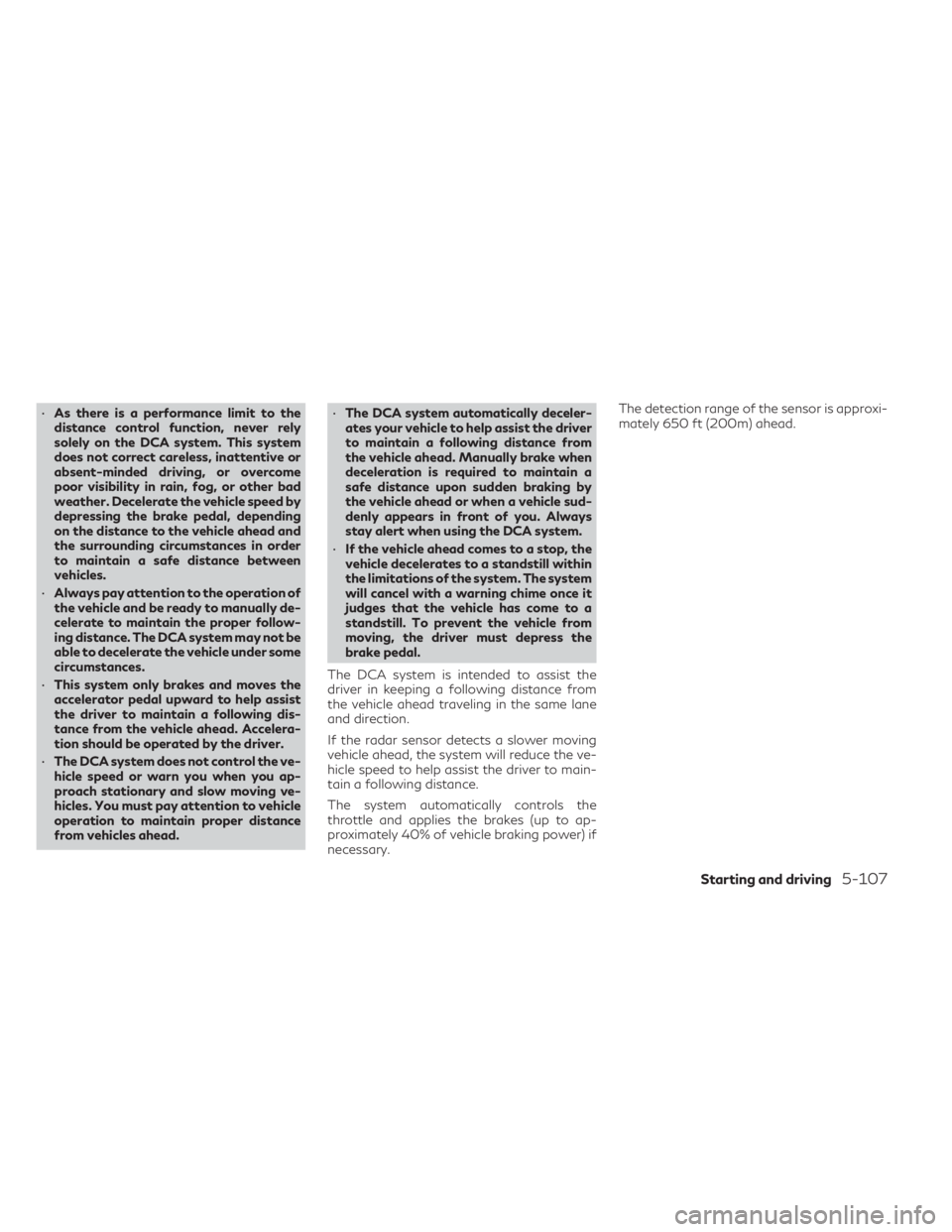
•As there is a performance limit to the
distance control function, never rely
solely on the DCA system. This system
does not correct careless, inattentive or
absent-minded driving, or overcome
poor visibility in rain, fog, or other bad
weather. Decelerate the vehicle speed by
depressing the brake pedal, depending
on the distance to the vehicle ahead and
the surrounding circumstances in order
to maintain a safe distance between
vehicles.
• Always pay attention to the operation of
the vehicle and be ready to manually de-
celerate to maintain the proper follow-
ing distance. The DCA system may not be
able to decelerate the vehicle under some
circumstances.
• This system only brakes and moves the
accelerator pedal upward to help assist
the driver to maintain a following dis-
tance from the vehicle ahead. Accelera-
tion should be operated by the driver.
• The DCA system does not control the ve-
hicle speed or warn you when you ap-
proach stationary and slow moving ve-
hicles. You must pay attention to vehicle
operation to maintain proper distance
from vehicles ahead. •
The DCA system automatically deceler-
ates your vehicle to help assist the driver
to maintain a following distance from
the vehicle ahead. Manually brake when
deceleration is required to maintain a
safe distance upon sudden braking by
the vehicle ahead or when a vehicle sud-
denly appears in front of you. Always
stay alert when using the DCA system.
• If the vehicle ahead comes to a stop, the
vehicle decelerates to a standstill within
the limitations of the system. The system
will cancel with a warning chime once it
judges that the vehicle has come to a
standstill. To prevent the vehicle from
moving, the driver must depress the
brake pedal.
The DCA system is intended to assist the
driver in keeping a following distance from
the vehicle ahead traveling in the same lane
and direction.
If the radar sensor detects a slower moving
vehicle ahead, the system will reduce the ve-
hicle speed to help assist the driver to main-
tain a following distance.
The system automatically controls the
throttle and applies the brakes (up to ap-
proximately 40% of vehicle braking power) if
necessary. The detection range of the sensor is approxi-
mately 650 ft (200m) ahead.
Starting and driving5-107
Page 350 of 542
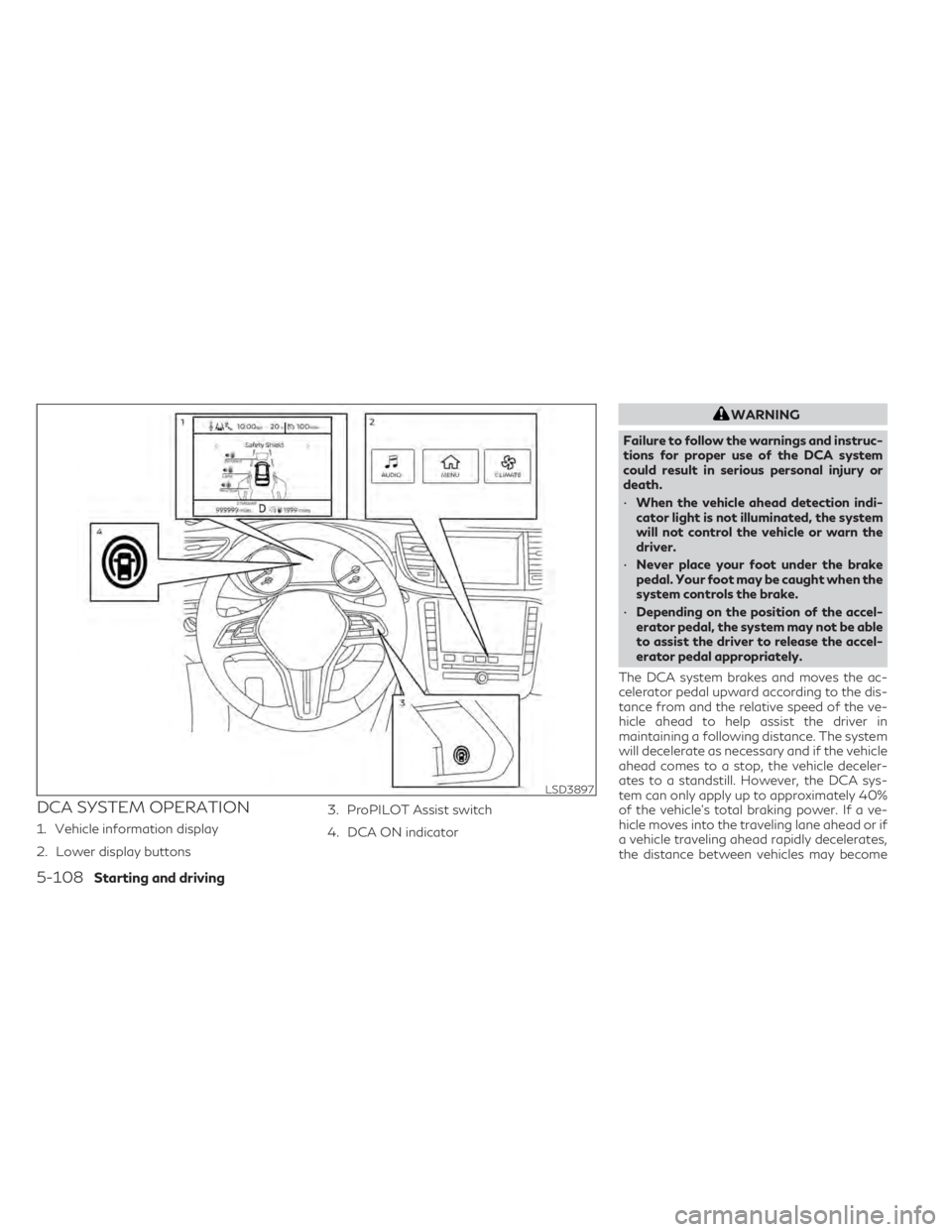
DCA SYSTEM OPERATION
1. Vehicle information display
2. Lower display buttons3. ProPILOT Assist switch
4. DCA ON indicator
WARNING
Failure to follow the warnings and instruc-
tions for proper use of the DCA system
could result in serious personal injury or
death.
• When the vehicle ahead detection indi-
cator light is not illuminated, the system
will not control the vehicle or warn the
driver.
• Never place your foot under the brake
pedal. Your foot may be caught when the
system controls the brake.
• Depending on the position of the accel-
erator pedal, the system may not be able
to assist the driver to release the accel-
erator pedal appropriately.
The DCA system brakes and moves the ac-
celerator pedal upward according to the dis-
tance from and the relative speed of the ve-
hicle ahead to help assist the driver in
maintaining a following distance. The system
will decelerate as necessary and if the vehicle
ahead comes to a stop, the vehicle deceler-
ates to a standstill. However, the DCA sys-
tem can only apply up to approximately 40%
of the vehicle’s total braking power. If a ve-
hicle moves into the traveling lane ahead or if
a vehicle traveling ahead rapidly decelerates,
the distance between vehicles may become
LSD3897
5-108Starting and driving
Page 351 of 542
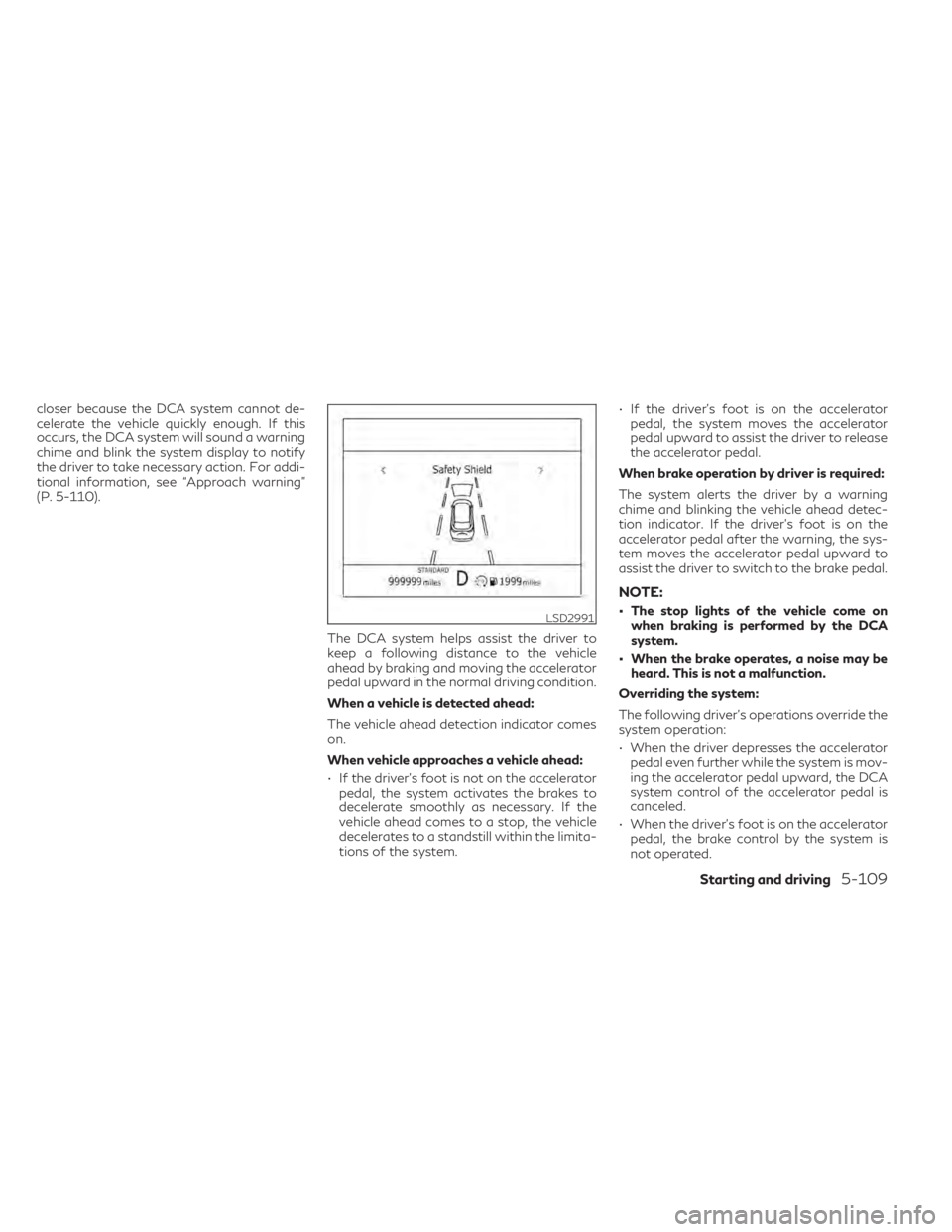
closer because the DCA system cannot de-
celerate the vehicle quickly enough. If this
occurs, the DCA system will sound a warning
chime and blink the system display to notify
the driver to take necessary action. For addi-
tional information, see “Approach warning”
(P. 5-110).The DCA system helps assist the driver to
keep a following distance to the vehicle
ahead by braking and moving the accelerator
pedal upward in the normal driving condition.
When a vehicle is detected ahead:
The vehicle ahead detection indicator comes
on.
When vehicle approaches a vehicle ahead:
• If the driver’s foot is not on the acceleratorpedal, the system activates the brakes to
decelerate smoothly as necessary. If the
vehicle ahead comes to a stop, the vehicle
decelerates to a standstill within the limita-
tions of the system. • If the driver’s foot is on the accelerator
pedal, the system moves the accelerator
pedal upward to assist the driver to release
the accelerator pedal.
When brake operation by driver is required:
The system alerts the driver by a warning
chime and blinking the vehicle ahead detec-
tion indicator. If the driver’s foot is on the
accelerator pedal after the warning, the sys-
tem moves the accelerator pedal upward to
assist the driver to switch to the brake pedal.
NOTE:
• The stop lights of the vehicle come on when braking is performed by the DCA
system.
• When the brake operates, a noise may be heard. This is not a malfunction.
Overriding the system:
The following driver’s operations override the
system operation:
• When the driver depresses the accelerator pedal even further while the system is mov-
ing the accelerator pedal upward, the DCA
system control of the accelerator pedal is
canceled.
• When the driver’s foot is on the accelerator pedal, the brake control by the system is
not operated.LSD2991
Starting and driving5-109
Page 358 of 542

For additional information about the VDC
system, see “Vehicle Dynamic Control
(VDC) system” (P. 5-154).
• When ABS or VDC (including the TCS) is operating
• When the radar signal is temporarily interrupted
Action to take:
When the conditions listed above are no lon-
ger present, turn the system off with ProPI-
LOT Assist switch on the steering wheel.
Turn the DCA system back on to use the
system.
Condition B:
When the radar sensor area is covered with
dirt or is obstructed, making it impossible to
detect a vehicle ahead, the DCA system is
automatically canceled.
The chime sounds and the DCA system
warning light (orange) will come on and the
“Unavailable: Front Radar Blocked” warning
will appear.
Action to take:
If the warning light comes on, park the vehicle
in a safe place, press the park button to place
the vehicle in the P (Park) position and turn
the engine off. When the radar signal is tem-porarily interrupted, clean the sensor area
and restart the engine. If the “Unavailable:
Front Radar Blocked” warning continues to
be displayed, have the DCA system checked.
It is recommended you visit and INFINITI
retailer for this service.
When driving on roads with limited road
structures or buildings (for example, long
bridges, deserts, snow fields, driving next to
long walls) the system may illuminate the sys-
tem warning light (orange) and display the
“Unavailable Front Radar Blocked” message.
Action to take:
When the above conditions no longer exist,
the DCA system will resume automatically.
Condition C:
When the DCA system is not operating prop-
erly, the chime sounds, the DCA system
warning light (orange) and the system “Mal-
function” warning message will appear in the
vehicle information display.
Action to take:
If the DCA system warning light (orange) and
the warning message appear, stop the ve-
hicle in a safe place and place the vehicle in
the P (Park) position. Turn the engine off,
restart the engine, and turn on the DCA sys-
tem again.
LSD2992
5-116Starting and driving